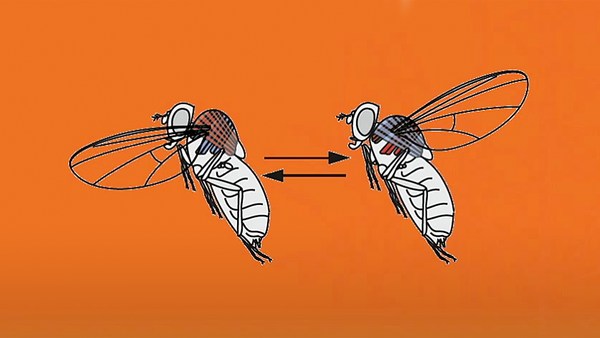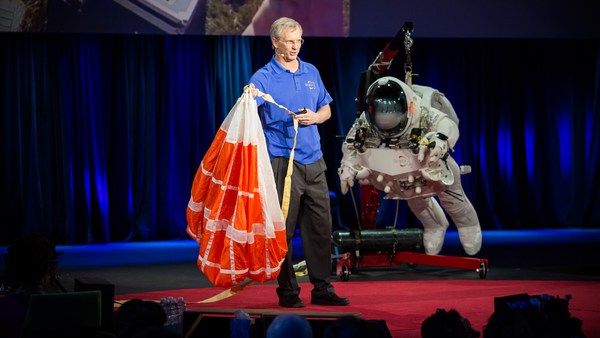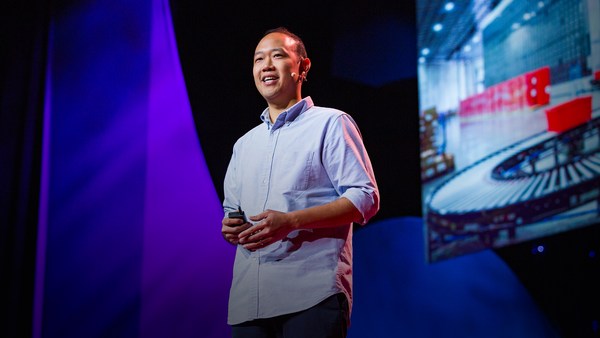Michael Browning: engineer, innovator -- inventor, really -- and inspiring father. He had a passion for flight, as you can kind of sense from that rather dubious 1970s office-leaving present. And some 40 years after that was created, a small group of us got together to have a go, a run at the whole challenge of flight that inspired people for years, and do it in a very different kind of way. And that's the journey I'd like to share with you now.
The starting hypothesis was one of the human mind and body, which, as you've seen for the last few days here, is an amazing construct. What if you augmented that wonderful machine with just the right technology? If you approach flight in that kind of real way, where could you get to?
So my training partner here back in London, Denton, is doing a much better job of that kind of stuff than me. Guess what? It's London. The idea was that you augment that. And so, how do you augment that? Well, we bought one of these.
This is a micro gas turbine. This was ground zero, so that little piece of kit proved really quite impressive, so we got two in a field. The real hero here, by the way, is, right in the background, there's a lady tending some vegetables, who does a brilliant job of trying to ignore us for a while --
(Laughter)
I think the only thing less happy is the grass, that we did probably damage quite badly.
You get an idea of the thrust here, when I try to hold them horizontally and somewhat fail. That's around 50 kilos of thrust there. We were quite impressed with that. We thought we were getting somewhere.
So there's only one sensible way to go from there: you get four.
(Laughter)
I have to say, I still like watching these back.
So then we thought well, let's try and spread the load a bit. The legs are designed to take the load, so why don't we spread it out a bit? That bit was good. The harness -- a nice idea but it didn't really work, as you'll see now. This whole journey was very much about trying things --
(Laughter)
Yeah, it really didn't work, did it?
Trying things and learning by failing at them most of the time. And that included failing by falling over. If you notice, we've got five engines here -- not to be put off by the fact one was in maintenance, still had a go.
(Laughter)
And then I pinched a fuel line. So again, good learning. We learned not to do that again.
This was a blind alley.
(Laughter)
This was three on each arm -- that was ridiculous. That was 70 kilos on each arm. Again, struck that one off.
(Laughter)
But we were starting to make some really quite convincing progress, just enough to make you believe that maybe -- maybe we could get there. You can see, look -- tantalizing. The model of one on each leg and two on each arm, on paper, that was enough thrust. And then we did what I'm about to show you now, and I still love watching this one. This was our first six-second, reasonably coherent flight.
(Applause)
That was the point where this endeavor went from: "I'm really not sure this is going to work," to: "Oh my god, it does work!" From there on we then refined it, but we carried on falling over a lot. Falling over, like I say, is definitely the best way to learn. After a while, we starting really refining the layout of all of this. And you'll see, that's stability and control -- there's no wires there or anything -- that's a combination of us refining the technology, including with a Tupperware box on the back for the electronics and actually learning the balance and control.
I'm now going to save your ears for the next short piece and talk over it. After a while, the jet engine noise is a bit annoying. This is only a few weeks ago. You can see the stability and control is really quite nice, and I'd like to think this somewhat validates that starting hypothesis, that the human mind and body, if properly augmented in that way, can achieve some pretty cool stuff. I mean, like I said: I'm not thinking about where I'm moving my arms at that stage. I'm looking at the objective of where I want to get to, and a bit like riding a bike, my arms are just doing their thing. It's a very strange experience.
So where is all this headed?
I'll talk over this landing -- I think I land in this one.
Well, I don't think anybody's going to go down to Walmart or take the kids to school in any of this stuff for a while, but the team at Gravity are building some awesome technology that's going to make this look like child's play. We're working on some things that will seek to bring this unusual experience of flight to a wider audience, beyond the events and displays we're doing. We're even starting to look for pilots two and three, if there's any volunteers.
I've got this vision. It sounds audacious, but let's just stick it out there, that one day maybe we can rise up above a beach, fly up and down the coastline of it, rise up a bit higher, with some of the safety kit we're working on to make this achievable. Then over the horizon comes a Hercules with the ramp down. As it comes past, you start picking up speed and see if we can intercept -- from the rear, not the front, that would be a mistake -- and then try and land in the back. And as I say, that's a little way off at the moment.
But this is also, if I take a big step back from this, this is also a very personal journey for me. Back to that lovely photo, or photo in a picture. Sadly, my father took his own life when I was 15, and left an awful lot of unfulfilled ambition. He was a wonderful inventor, a maverick creator. And I'd just like to think, if it was possible, if he was looking down, he would be -- he'd certainly be smiling at some of the things we've done here, I think. So, it's a tribute to him.
Thank you very much.
(Applause)
(Voice-over) Richard Browning: I'm probably more nervous about doing the demo after this. I've got a lot of things to get done today. Worst-case scenario, we don't get a clean start.
Or we get an unplanned failure while I'm actually flying around. This is why we keep it very low, so the worst is I just look like an idiot and fall on my rear, as I said. So you can all enjoy that if that happens.
(Music)
(Jet engine accelerates)
(Cheers)





